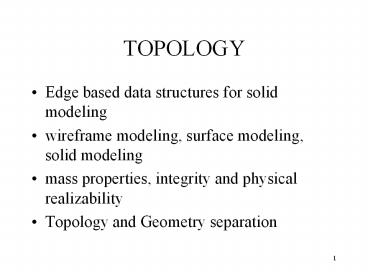TOPOLOGY - PowerPoint PPT Presentation
1 / 20
Title:
TOPOLOGY
Description:
mass properties, integrity and physical realizability. Topology and ... based vs. Spatially based. Evaluated vs. ... study of properties invariant under ... – PowerPoint PPT presentation
Number of Views:116
Avg rating:3.0/5.0
Title: TOPOLOGY
1
TOPOLOGY
- Edge based data structures for solid modeling
- wireframe modeling, surface modeling, solid
modeling - mass properties, integrity and physical
realizability - Topology and Geometry separation
2
Solid modeling representations
- Boundary based vs. Volume based
- Object based vs. Spatially based
- Evaluated vs. Unevaluted
- Focus on boundary based, object based, evaluated
form - Various data structures for topology for planar
and curved surface forms
3
Topology Data Structures
- V-E, F-E structures focus on use of edges
- Easy access to which side or end of edge is
intended - Simpler access procedures which are fast
- Requires additional data model elements
- New structures proposed by Weiler
4
Graphs and Adjacency
- Solid model has many kinds of information
including surfaces and adjacency relationships - Adjacencies can be derived using numerical
techniques with high computational expense - Evaluated representations have adjacency
information explicitly
5
Graphs and Adjacency(contd)
- Adjacency information is referred to as the
topology of solid model - geometry descriptions (point, curve, surface
definitions) are then geometry of solid model - Topology serves as the framework to glue various
pieces of information
6
Graphs and Adjacency(contd)
- Topology is saved in graph format
- Embedded graphs of boundaries and the topology
relationships - Vertex - a unique point
- Edge - an unordered set of 2 vertices
- Graph - a set of vertices and set of edges that
use the vertices
7
Graphs and Adjacency(contd)
- Multigraph - a graph where multiple edges can
join the same 2 vertices - Self Loop - an edge joins a vertex to itself
- Pseudograph - a graph that allows both self-loop
and multiple edges - Labeled graph - a graph in which each vertex and
edge is uniquely identified
8
Topology Concepts
- Topology is study of properties invariant under
homeomorphisms - Homeomorphism is a one-to-one, onto, topological
transformation that is continuous and has a
continuous inverse - Example open-disk - 2d
- open sphere 3d analog of the open disk
9
Topology Concepts
- A manifold, in particular, a two-manifold is a
2-d connected surface where each point on the
surface has a neighborhood topologically
equivalent to an OPEN DISK - Embedded graph Drawn on a surface so that no
two edges intersect, except at their incident
vertices
10
Topology Concepts
- 9 element adjacency relationships (see figure 1
page 23 in class notes) - VV, EV, FV, VE, EE, FE,
VF, EF, FF - Ordering terminology group - unordered list,
(group) - linear ordered list, ltgroupgt - circular
ordered list - ltVgt - group of 0 or more circular vertices
11
Graph Data Structures
- Based on edge as the reference
- WE - winged edge, MWE - modified winged edge ,
use of edge structures - Shell structure list of faces
- face structure next, last, one vertex, edgelist
- vertex structure x, y, z coordinates
12
Topology data structures
- Inference analysis tasks need only check the
higher level shell extents - Backpointers are also common for efficiency
purposes - Winged Edge (WE structure) Provides boundary
graph of faces, edges, vertices. Also provides
for euler operators
13
Winged Edge (WE) structure
- Adjacency of given edge with other edges
- edge pointers to vert1, vert2, cwe1, cwe2,
ccwe1, ccwe2, face1, face2 (Figure 3, page 26) - graphical appearance w.r.t. reference edge
- cw and ccw looking from outside the volume
toward surface.
14
WE, MWE structures
- E(V)-E((E)(E))-E(F) is available in WE
- Modified Winged Edge Structure Has additional
data. Each cwe, ccwe pointers have edge-side
fields cwe - cwehalf, ccwe- ccwehalf (figure 4,
page 26) - Reduces algorithm complexity - in curved surfaces
15
Additional structures
- V-E structure edges around a vertex forms a
circular- ordered list (cwe field) - F-E structure edges around a face forms a
circular-ordered list (cwe field) - each side of
edge is used only once as boundary of face - many variations with back-pointers are possible
16
Topological Sufficiency
- Representation has data operators
- complete specification of the domain, proof of
sufficiency, operators that cover entire domain
yet cannot violate domain - compact, orientable two-manifolds, embedded graph
adjacency topology, pseudographs (figure 7, page
28)
17
Topology sufficiency
- Labeled graphs to attach attributes, uniqueness,
derivable relationships with other entities - sufficiency is to recreate all 9 topology
relations without error/ambiguity - VltEgt, FltEgt, some EE sufficient individually over
the selected domain
18
Conclusions
- WE, MWE, V-E, F-E structures
- 3 of four sufficient topologically
- WE needs additional data/algorithms to deal with
curved surface environments - needs to be aware of domain and occurrence of
elements (use) - WE, MWE have better record-accessing
19
Conclusions
- MWE has better efficiency w.r.t. WE
- V-E, F-E better performance for complex adjacency
querries - V-E, F-E require 20 more storage than W-E, MWE
structures - F-E is particularly well suited for hierarchical,
edge-oriented, evaluated, object based, boundary
graph solid models
20
STEP STANDARD
- ISO-10303 is an international standard for
product data exchange (Standard for Exchange of
Product Model Data) - Modules AP203, AP209, AP224 etc.,
- geometry, product identification, product
structure(assembly), configuration, manufacturing
features, tooling, processes etc.,































